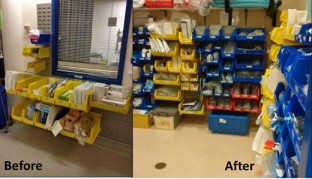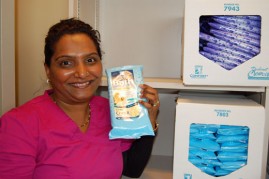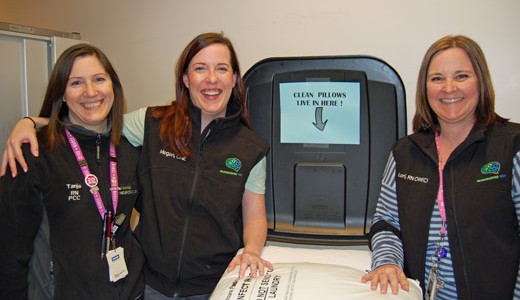Teams unearth supply treasure troves
Is there hidden treasure in your store room? Untapped savings in that supply cart, or perhaps you’ve unearthed an artifact better suited to a museum than to patient care?
These are questions VGH and UBC Hospital teams are asking themselves on their quest to reduce supply waste and earn cash rewards — yes, you read that right.
Cash for savings
“Supply waste costs the system money and our staff precious time,” says Shelly Fleck, director, special projects. “We would rather invest those funds into the delivery of care and our people.”
Launched as a pilot last summer, the Vancouver Acute Supply Utilization Initiative now spans all VGH and UBCH inpatient medicine, surgery and perioperative units. With the support of Health Shared Services B.C. (HSSBC) and VCH Finance, each team aims to save at least 1 per cent in annual supply costs. In return, teams will be rewarded an incentive equal to 10 per cent of achieved savings, which they can use for continuing education, new chairs or whatever the group chooses.
“We want to minimize waste while making sure we’re using the most appropriate and safest products, in the right quantities,” says Shelly, “and the best people to help us do that are the staff and physicians who work with these supplies every day.”
Digging in and digging deep

Before the initiative, the Urgent Care Centre at UBC Hospital had supplies crowding hallways and stockpiled in numerous locations.
Before the initiative got off the ground, the VGH Neurosciences unit was already digging in. Staff and clinicians had identified many saving opportunities — from adding a new bin for clean pillows to prevent ‘hoarding’ in patient rooms, closets and store rooms, to practice changes with surgeons and Medical Device Reprocessing to save time and money in the OR.
“Auditing and streamlining our stock rooms was another huge task, but very cathartic,” says Megan Fekete, clinical nurse educator.
Scattered stockpiles aren’t unique to VGH. “We found a lot of hidden supplies,” says Natalie Schaper, interim patient care coordinator/educator, at the UBCH Urgent Care Centre. “Some staff felt they needed their own stash to ensure they’d have what they need when they need it. The problem is, many supplies expired before they were used, and some were so old they aren’t used at all anymore.”
Savings are found when teams standardized and centrally stored their supplies in supply rooms or on carts. Fewer items are required and there’s never a question about where to find what you’re looking for, saving time, too.
Waste not, want not

Thanks to Rashmi Kumar’s observations, the VGH Subacute Medicine team has begun to save big on costly clean wipes.
Back at VGH, Reshmi Kumar, a patient care aide in Subacute Medicine, had been expressing concerns about the costly waste of clean wipes. These wipes come pre-packaged in quantities of three or eight, some pre-medicated with a barrier cream, says Doris Bohl, clinical nurse educator.
“Once you take a package into a patient room it must be thrown out, even if you don’t use all of them, and the expensive pre-medicated wipes are safely replaced by applying cream directly.”
So, in January, Subacute Medicine stopped using the pre-medicated wipes. Doris and her colleagues have also requested a product change from eight-pack to five-pack clean wipes, which will significantly reduce waste.
The potential savings are in the tens of thousands and, more importantly, says Doris, “we’re saving money without compromising patient care.”
Potential savings substantial
With supply rooms appropriately stocked, the next step is color coding supplies by cost. VGH Thoracics and the Transitional Care unit at UBCH are helping test this bright solution.
“Our idea isn’t to eliminate the use of certain products,” says Shelly, “but rather to raise awareness about supply costs and become more mindful of our choices.”
All these efforts could add up to a treasure trove of savings and efficiency improvements. Our aim is to save at least $700,000 in annual supply costs across the two hospitals.
“It will take time before the savings flow through,” says Shelly. “This is a transition year, but we’re feeling confident that we’ll start to see the financial benefits next year, when we realize the savings and have bigger returns.”
Do you have a supply savings idea? Let your supervisor know or email Shelly Fleck today.

